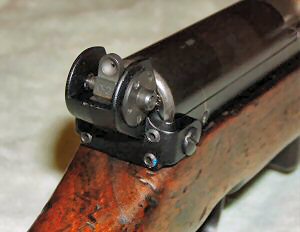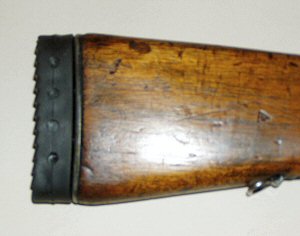The U.S. Service Rifle M-16 and it's commercial AR-15 spawn are arguably the single series rifles that most fits the intent of promoting good standards for a "well regulated" citizenry. So much so that it was mentioned as such during the Supreme Court's deliberations on the subject by Justice Ginsberg. It has rightfully become the most popular rifle in the country. It has become as ubiquitous as the bolt-action rifle that revolutionized all aspects of firearms use at the beginning of the 20th century.
The availability of California Legal variation of the M-16/AR-15 competition platform with legal 10-round fixed magazines that have "safety critical" bullet button technology incorporated into the modified lower receivers has made the State of California a competitive home for high-power competitors. It allowed the California Grizzlies Junior Rifle Team to win the prestigious Infantry Trophy at Camp Perry, something not done by a civilian team in decades and never by a junior team in the history of national competition since it was established following the report to Congress by President Theodore Roosevelt in 1903 on the need to promote rifle practice due to the sorry state of American marksmanship in the Spanish-American War.
Still, the 2012 variations of the California adapted AR-15's, while usable for competition and recreational shooting, remain tactically clumsy in comparison to the standard versions of the genre available to most citizens of the United States of America. Any real expert in firearms knows this. Anyone who does not reveals only how little they know about guns.
What follows is an old article originally penned in 2006 from the days before the "bullet button" existed. The objective of the project was to set up a high-power competition training rifle that could be used by a shooter still sensitive to the M-1 Garand. It was a gun limited to 100-yard reduced range events, a woeful coping strategy at best to explore a field of competition that is one of the apexes of the rights of citizenship. The need at the time was particularly acute for a junior training in California where it remains illegal for a minor to even handle a California statutory registered assault weapon.
A Desperate Shooting Project:
Improving the SKS for 100-yard Reduced Course Competition

The SKS rifle is an excellent rugged rifle capable of remarkable shooting accuracy but it suffers from deficiencies that detract from it's potential in its original military use designed configuration.
HERE's THE FLAW: The SKS rear sight design suffers from a too short sight radius that amplifies elevation errors in the sight picture but more important it wobbles from side-to -side several MOA under light finger pressure. The randomness is at typically greater than 6 to 8 MOA, larger than the bullseye of an NRA SR target. So much for windage repeatability. The gun actually shoots where the sights point. It's where the sights are pointing that changes from shot to shot.
The gun was intended for delivering fire employed by soldiers on the move where such drawbacks are not of great concern. For target shooting however, something rock steady with the longest possible sight radius is called for.

A company named Tech-Sights www.tech-sights.com makes a sight that seems to address this deficiency. The unit doubles the sight radius and zeros the side-to-side play of the rear sight. It also sets up an aperture rear which is a much better sight for precision shooting. Elevation zero is done by adusting the front sight. No wind zero can be done by setting the rear to mechanical center and adjusting the SKS front sight to center the hits. Quite an improvement!
Tech-Sights also has an elevation adjustable rear version. Examined of it reveals that it is not useful for competitive purposes. More useful would be a variation that uses the attachment approach of the sight onto the rifle but with the rear sight itself using M-16A2 sight parts. That I would very much like to see.
Note: While Tech-Sights says it's optional to use the locking screw to tighten down the sight to the gun, it is in fact essential. It does shoot loose with predictable regularity unless this precaution is used. The rule of thumb to remember is that no manufacturer ever adds an extra piece of machined steel in the box unless there was a need for it.

A rubber butt extension has been placed on the rifle to provide more appropriate eye positioning with respect to the new rear sight. It makes a big difference and should be considered essential. And it's much cheaper than any aftermarket stock.
I have experimented with various aftermarket stocks for the SKS; specifically, the ATI Monte Carlo stock and the Choate Sporter stock. The ATI is quite solid but the cheekpiece is set up for scoped rifles and does not work well with the TS100 sights. This stock seems better suited for a forward mounted optic project but that's not what we are working towards here.
The Choate stock is made from thin material, flexes in your hand and the action moves around in the stock. These are not ideal for a target gun. The stock does however have a very nice hand grip compared to the military stock particularly for providing better purchase for the ring and pinky fingers to grab. It has potential for exploring adding a cross bolt and bedding compounds to tighten the bedding of the action.
In the end there is a strong case to choose to continue to use the original military stock. The reason is because of the cross bolt in the military stock that creates a solid bedding for the rifle. It wedges the barrel at the action/barrel junction and in combination with the clamping action of the trigger assembly and recoil lug at the rear of the action provides two points of solid contact for the action. The barrel then free floats forward of the cross bolt. It's both solid and rugged. Neither of the aftermarket SKS stocks tested afforded this superior bedding method. So for target rifle purposes, stick with the better bedding solution.
For match shooting be sure to lighten the barrel mass by removing excess metal objects like the bayonet. Also, there needs to be a sling mount point on the fore end for the sitting and prone positions. Using the mount point on the barrel defeats the whole purpose of the exercise.
Results
With the new sights in the military stock the gun now shoots in the 1" to 2" range at 100-yards using surplus ammunition. That is plenty good enough for club level competitions.
Using stripper clips, the rifle can perform well in the rapid fire stages of a highpower match.
Elevation adjustments are workable and repeatable using an SKS sight tool to adjust the front sight in a manner rather similar to using an M-16A1 sight system. Interestingly, because the SKS front sight is a continuous screw instead of a detent like the M-16 design, even finer adjustments are possible.
The training system is limited to fixed distance reduced course work but it should work well enough for either 100-yd or 200-yd training matches.
Bottom line. This is not a substitute for a properly tuned match grade AR-15 with a 1-7/1-8 twist free floated barrel firing match quality ammunition. The reality remains that you still need a real "competition rifle" to be anything respectable in this segment of the shooting sports.
No comments:
Post a Comment